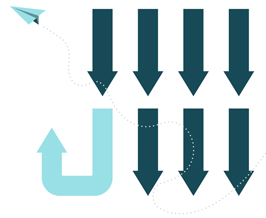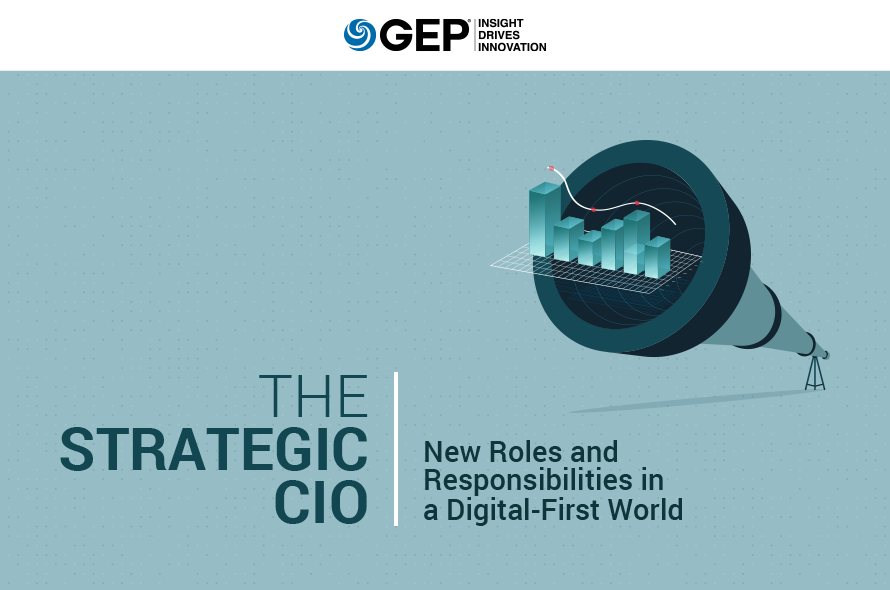In the digital transformation era, CIOs have a tantalizing opportunity to reinvent themselves and embrace new, strategic responsibilities: unlocking competitive advantage, revenue building, and creating the technological backbone for the entire enterprise.
What does a strategic-minded CIO need to guide the business on its digital transformation journey? What can CIOs do to link their priorities to broader business goals? And which metrics will measure the performance of a strategic CIO?
In a new white paper, The Strategic CIO: New Roles and Responsibilities in a Digital-First World, GEP presents an action plan for CIOs seeking to manage change effectively and emerge as digital enterprise leaders.
Why Read It:
- Why CIOs need to be multi-faceted leaders to maximize digital potential
- How CIOs can better drive value from their enterprise’s technology investments
- Why working with people — from employees to customers — is now critical to the CIO’s role
An essential read for CIOs and IT professionals who want to drive their business impact to new levels.
As companies of all sizes, in every industry and market, transform themselves into digital enterprises, the role of the CIO has evolved — from an operational leader responsible for implementing technology and making it work correctly to a strategic leader who creates competitive advantage for the enterprise by delivering innovation and added value.
With digital transformation taking center stage and the lines between technology and operations blurring, CIOs are expected to lead enterprise-wide technology strategy and decision-making; they must concern themselves with driving business innovation.
Externally, IT leaders are actively identifying opportunities for competitive differentiation, working on new go-to-market strategies and technologies, working to offer better customer experiences, and keeping their fingers on the market’s pulse. Internally, CIOs are focused on making the right budget allocations for digital initiatives, digitally transforming processes, advancing technology adoption, guarding against operational risk, enforcing compliance, and keeping costs under control.

MEETING BOTTOM-LINE TARGETS
Business operating models are witnessing significant changes because of digitalization. Consequently, the CIO’s role is shifting from IT- outcome-focused to business-outcome-focused. The coming year will see more investment in IT and more effort directed at achieving bottom-line goals through technology.
As CIOs make the transition from a tactical role to a strategic one, the dynamics will change — they will not just be supporting other functions, but collaborating with them, shifting from cost control to revenue building, from process re-engineering to data exploitation, from the IT domain to the entire enterprise, becoming its de facto technological backbone. A large component of the CIO’s role would be relationship management with C-level executives and collaborative agenda-setting for the organization.

THE EVOLVING ROLE
For the majority of CIOs, who have so far been looked upon as facilitators or orchestrators of IT services, the primary challenge of this role-shift is that they will have to operate without a blueprint that they can follow. Strong business partnerships combined with visionary leadership will be key ingredients for the success of the augmented function. The new role will encompass some of these aspects:
Focusing on Business Goal
Future CIOs, instead of only focusing on digitalization and budgets, will be expected to spend more time joining technology services to business needs to achieve business goals. Now, more than ever, the job will be about prioritizing and identifying which specific initiatives will change business models and drive consumer engagement, product management and technology.
Putting in Place a Digital Culture
The implementation of digital culture across all business units of an enterprise will also be a new responsibility for many CIOs as another step beyond basic technology enablement.
Looking Outward
The CIO will be expected to concentrate more on outward-focused activities that create business value and help streamline IT operations.
A Multifaceted Position
The CIO will hold the key to unlocking business benefits and relevant customer engagement, often donning different hats — that of entrepreneur, ideator and disruptor. Various key technology roles will also become a part of the CIO’s mandate, for example, that of the Chief Digital Officer, Head of Digital Security and Chief Data Officer.
Redefined Priorities: Looking to the Future
The change in job role translates to added responsibilities and new priorities for the CIO. While they will continue to be technology enablers, CIOs, now at the helm of the organization’s digital transformation journey, will have far more on their plate.
Balancing IT Spend
CIOs must allocate funds judiciously for digital transformation, which balances automation and disruptive technologies such as artificial intelligence (AI) and blockchain with the existing infrastructure. Many CIOs believe their tech budget will go up in the near future because of investments in new technologies, innovative operating models and greater involvement with emerging vendors.
Ditching the Legacy
Legacy systems are often a hindrance to transformation. CIOs are concentrating on cloud technologies and agile methodologies that are faster, scalable and more flexible, making it easier to focus on adding value. Their mission is to actively shift from cost control and spend management to value creation and enterprise growth.
Concentrating on Innovation
Considering the rate of change and the deployment speed of new technologies, it’s imperative for CIOs to become advocates for agile methods, continuous integration and simplified governance if they want to radically reshape the business environment and facilitate innovation.
Increasing Involvement in Product Development
CIOs are also getting more involved in the product development process, taking ownership of advanced technology groups tasked with evaluating emerging technologies, identifying gaps and opportunities, and taking them to the market.
THE ACTION PLAN
CIOs need to come up with strategies to handle challenges they will encounter during the process of digital enterprise transformation and when they are trying to drive more value from digital investments. Sometimes the challenges have to do with people and change and oftentimes it is the technology itself that demands a fresh approach.

Enforcing the Digital Culture
CIOs not only have to implement and enable digital strategies, they must also inspire the organization through technology. A common hurdle is facing institutional resistance to this paradigm shift.
Action Needed: Increasing technological awareness within the organization will help leverage “digital” to its full potential. It will also help create a better employee experience and enhance understanding among C-level executives.
Transforming People and Processes
CIOs often face obstacles to promoting digital collaboration due to substandard existing processes in the enterprise. To enable free-flowing information and end-to-end visibility, there is a need for process transformation and intuitive workflows across business units. Here, it is important to train and equip employees to leverage process and technology transformation. A dearth of required skills and prioritization of the organization’s operational tasks can limit the scope and impact of digital initiatives.
Action Needed: To work effectively within an integrated ecosystem, employees must be trained and processes facilitated so that they can work together in new ways, breaking down silos and collaborating across departments. Implementing a digital workplace is a highly recommended method of breaking through the technology bottleneck. In this new digital environment, CIOs must continuously upskill and re-train the current workforce, retain trained talent and prevent knowledge leakage.
Creating a Digital Workplace
CIOs must provide employees with a high-quality digital workplace if they expect employees to improve service to customers. According to Gartner, by 2020, the biggest source of competitive advantage for more than 25 percent of enterprises is expected to come from workforce agility, increased productivity and the ability to creatively make use of different digital technologies1.
Action Needed: Creating a digital workplace through business process management and workflow automation, process automation, task flow unification, and a virtual workforce will improve efficiency, productivity and technological compatibility.
Ensuring Data Security and Accessibility
Organizations are investing in unified platforms and solutions to ensure information and data fluidity, to reduce silos and to facilitate digital collaboration across the board. This, however, comes with certain caveats — the biggest challenge for the CIO is to deliver effective security while sustaining agility and data access. The lack of resources and discipline to manage crucial information remains a major problem for most companies. Effective data classification is crucial for maintaining security and fluidity.
Action Needed: Explicit governance around data ownership and implementation of data- centric security technologies are necessary, for which CIOs will have to evaluate the type of data and understand the level of control required. The right tools supported by effective policies can enable users to make better data-driven decisions, which will have a positive impact on the company’s bottom line.
Building Cyber Resilience
Cyberattacks are not just a technology concern but a massive business risk, and companies expect CIOs to manage this issue. As privacy regulations get tougher, CIOs must work not just to protect the business from frauds and monetary and asset thefts; they have to also closely guard data.
Action Needed: By aligning cybersecurity strategy with the larger business plan, investing adequately in this area, preparing the cyber workforce for impending threats and staying informed and vigilant, the CIO can help the organization remain secure, avoid losses and maintain its credibility and reputation.
Managing Operational Risk and Compliance
Many enterprises still have a limited understanding of how the European Union’s data protection laws, GDPR (General Data Protection Regulation), can impact them. Previously, compliance initiatives were driven by national legislation, but now, with the implementation of GDPR, organizations must manage and safeguard the large amounts of data they produce in line with the new law. Further, the trend of BYOD (Bring Your Own Device) and the use of various devices by organizations to interact with third parties mean that CIOs must be extra vigilant about the flow of data across devices and its effects. The failure to comply with data regulatory requirements can invite huge penalties.
Action Needed: CIOs have to be proactive and implement extensive programs across their companies for GDPR compliance. To govern data appropriately, it must be properly defined and labeled consistently. Organization-wide training and awareness programs are necessary to make both enterprises and their employees more accountable for data security.
Harnessing Emerging Technologies
Technology priorities are changing constantly, based on the tools that organizations have implemented in the past and their current needs. The CIO has to gauge the importance and relevance of emerging technologies from the organization’s perspective and use tight budgets sensibly, focusing both on internal operations and business growth.
Action Needed: CIOs in leading enterprises are already harnessing the benefits of emerging technologies such as AI, big data, analytics, blockchain and robotic process automation (RPA). There will be increased investment in AI, automation, business intelligence (BI) and analytics, and other new technologies in the near future.
Leveraging the Cloud
Many organizations are getting rid of their legacy systems and focusing on agility, motivated by the rapid development of cloud technology, which has advanced significantly in terms of efficiency, performance, security and cost-effectiveness in recent years. According to Gartner, by 2020, anything other than a cloud-only strategy for new IT initiatives will require justification in more than 30 percent of large enterprises. In the years to come, it is forecast that more than half of global enterprises will adopt an all-in-cloud strategy2.
Action Needed: Cloud computing must be a critical element of the CIO’s IT strategy. Implementing cloud-based solutions not only mitigates the risk of spiraling infrastructure and support costs while ensuring greater flexibility, scalability and accessibility, it also increases agility and gives the company a competitive edge. The CIO must prepare the organization for different cloud offerings (public, private or hybrid, SaaS, PaaS or IaaS, etc.), as well as prep to incorporate cloud innovations (such as serverless computing or quantum computing).
Digitalizing Customer Experience
Sometimes enterprises, while going through their digital transformation journey, don’t consider their end customers, or lack a clear vision for their customers’ digital journey. Having this perspective can be a key differentiator, instrumental in making or breaking the business. With the rise of new technologies, companies must rethink how to reach out to their customers and how to enhance customer experience. Focusing on consumer experience as a point of differentiation can create lasting relationships with customers.
Action Needed: The CIO must bridge the gap in perspective, factoring in the customer’s viewpoint in the company’s digital transformation journey and leveraging customer data to provide better products and services. When it comes to the customer journey, CIOs must play a proactive role in envisioning the technology, its planning and execution as they understand what’s technically possible, what’s required for successful integration, and what features will enhance usability. They are the ones who can determine how to reconcile the need to digitally transform with the needs of customers for a positive experience.
IT’S TIME FOR CHANGE
The CIO’s trajectory needs some course correction, as more and more businesses transform themselves into digital entities. The future CIO will not be just an implementer of technology, but is expected to hold the key to unlocking competitive advantage, business benefits and relevant customer engagement. To act as agents of change, CIOs themselves must be open to change first. They must link their priorities to broader business goals and become accountable for the results.
As the CIO’s role — like that of other C-level executives — becomes more strategic and more integral to the business, the metrics for CIOs will also change to make them more accountable for the ultimate effectiveness of the technology within the organization. As we step into the future, CIOs can expect to be assessed on these parameters: vision, customer-centricity, creating a technology-driven business, and talent management.
References
- Clint Boulton, “Digital Workplace Strategy: 8 Steps to Greater Agility, Productivity,” CIO, 18 January 2019. Retrieved 7 May 2019 from www.cio.com/ article/3229104/the-digital-workplace-8-steps-to-greater-agility-productivity.html
- David Mitchell Smith, “Cloud Strategy Leadership: Gartner Insights on How and Why Leaders Must Implement Cloud Computing,” Gartner, Inc., 2017. Retrieved 7 May 2019 from www.gartner.com/imagesrv/books/cloud/cloud_strategy_leadership.pdf
Additional References
- “2019 CIO Priorities,” Spok. Retrieved from spok.com/infographic-cio-priorities-2019
- “CIO Challenges in the Age of Digital Transformation: Analysis and Outlook,” i-SCOOP. Retrieved from i-scoop.eu/cio-challenges-age-digital- transformation-analysis-outlook/
- “CIO Role Evolution Primer for 2019,” Gartner, 22 January 2019. Retrieved from gartner.com/en/documents/3898874-cio-role-evolution- primer-for-2019
- “The Digital Workplace: How Technology Innovation Can Drive a Return to Productivity Growth,” GEP. Retrieved from smartbygep.com/ insight/white-papers/digital-workplace-how-technology-can-drive-productivity-growth
- “A Guide to the CIO’s 2019 Tech Priorities,” IDG, 12 April 2018. Retrieved from idg.com/blog/a-guide-to-the-cios-2019-tech-priorities
- “New on the CIO Agenda: Helping Procurement Succeed in Digital Transformation,” GEP. Retrieved from smartbygep.com/insight/white- papers/supporting-digital-procurement-transformation-on-cio-agenda
- “Role of CIO Is Changing and Growing in Importance, Say New Forbes Insights Studies,” Forbes, 28 March 2018. Retrieved from forbes.com/ sites/forbespr/2018/03/28/role-of-cio-is-changing-and-growing-in-importance-say-new-forbes-insights-studies/#54733a19426c
- Bendor-Samuel, Peter. “How the CIO Role Must Change Due to Digital Transformation.” Forbes, 30 January 2019. Retrieved from forbes. com/sites/peterbendorsamuel/2019/01/30/how-the-cio-role-must-change-due-to-digital-transformation
- Boulton, Clint. “5 Enterprise Cloud Strategy Trends for 2019,” CIO, 18 June 2019. Retrieved from cio.com/article/3137946/6-trends-that-will- shape-cloud-computing-in-2017.html
- Couture, Nancy. “How Data Governance Can Support Data Privacy Compliance,” CIO, 7 February 2019. Retrieved from cio.com/ article/3338999/how-data-governance-can-support-data-privacy-compliance.html
- Eide, Naomi; Schwartz, Samantha Ann; and Hickey, Alex. “7 Takeaways from Gartner Defining the CIO Role,” CIO Dive, 22 October 2018. Retrieved from ciodive.com/news/7-takeaways-from-gartner-defining-the-cio-role/540269/
- Goodchild, Joan. “How to Make Data More Accessible at All Levels With Access Controls and Strong Governance,” CIO, 3 December 2018. Retrieved from cio.com/article/3323069/how-to-make-data-more-accessible-at-all-levels-with-access-controls-and-strong-governance.html
- Heltzel, Paul. “The 11 Biggest Issues IT Faces Today,” CIO, 15 February 2019. Retrieved from cio.com/article/3245772/the-12-biggest-issues- it-faces-today.html
- High, Peter. “Top CIO Priorities: The Threat of Amazon, Customer Experience, Data Insights, and Data Security,” Forbes, 29 October 2018. Retrieved from forbes.com/sites/peterhigh/2018/10/29/top-cio-priorities-the-threat-of-amazon-customer-experience-data-insights-and-data- security/#2e3547814360
- Lago, Cristina and Trueman, Charlotte. “How to Find and Implement Emerging Technologies as a CIO,” CIO, 21 November 2018. Retrieved from cio.com/article/3296703/how-to-find-and-implement-emerging-technologies-as-a-cio.html
- Lago, Cristina. “What Does the Future CIO Role Look Like?” CIO, 16 April 2019. Retrieved from cio.com/article/3300761/what-does-the- future-cio-role-look-like.html
- Loh, Jean. “CIO Priorities For 2019: IT Thought Leaders Share Their Predictions,” D!gitalist Magazine, 9 January 2019. Retrieved from digitalistmag.com/cio-knowledge/2019/01/09/cio-priorities-for-2019-it-thought-leaders-share-their-predictions-06195645
- Macaulay, Thomas. “How CIOs are Ensuring GDPR Compliance,” CIO UK, 16 July 2019. Retrieved from cio.co.uk/it-strategy/how-cios-are- ensuring-gdpr-compliance-3673623
- Panetta, Kasey. “10 CIO Resolutions for 2019,” Gartner, 9 January 2019. Retrieved from gartner.com/smarterwithgartner/10-cio-resolutions- for-2019
- Piercy, Matt. “Secure Cloud Transformation: A Four-Step Strategy for the CIO,” CloudTech, 5 February 2019. Retrieved from cloudcomputing- news.net/news/2019/feb/05/secure-cloud-transformation-a-four-step-strategy-for-cios
- Pratt, Mary K. “Secrets of Highly Innovative CIOs,” CIO, 9 January 2018. Retrieved from cio.com/article/3245850/6-secrets-of-highly- innovative-cios.html
- Preston, Rob. “Top 10 Strategic CIO Priorities For 2019,” Forbes, 28 January 2019. Retrieved from forbes.com/sites/oracle/2019/01/28/top- 10-strategic-cio-priorities-for-2019/#23033e724750
- Rosenbush, Steve. “The Changing Role of the CIO,” The Wall Street Journal, 20 December 2018. Retrieved from blogs.wsj.com/ cio/2018/12/20/the-changing-role-of-the-cio
- Sambandam, Suresh. “The Top 3 Priorities for CIOs,” InformationWeek, 7 November 2018. Retrieved from informationweek.com/strategic- cio/it-strategy/the-top-3-priorities-for-cios-/a/d-id/1332260
- Suer, Myles F. “Top Priorities for CIOs in 2019,” CIO, 20 December 2018. Retrieved from cio.com/article/3329741/top-priorities-for-cios- in-2019.html
- Tucker, Ed. “GDPR for the CIO: Data Protection Is About More than GDPR Compliance,” Computer Weekly, 26 September 2017. Retrieved from computerweekly.com/opinion/GDPR-for-the-CIO-Data-protection-is-about-more-than-GDPR-compliance

